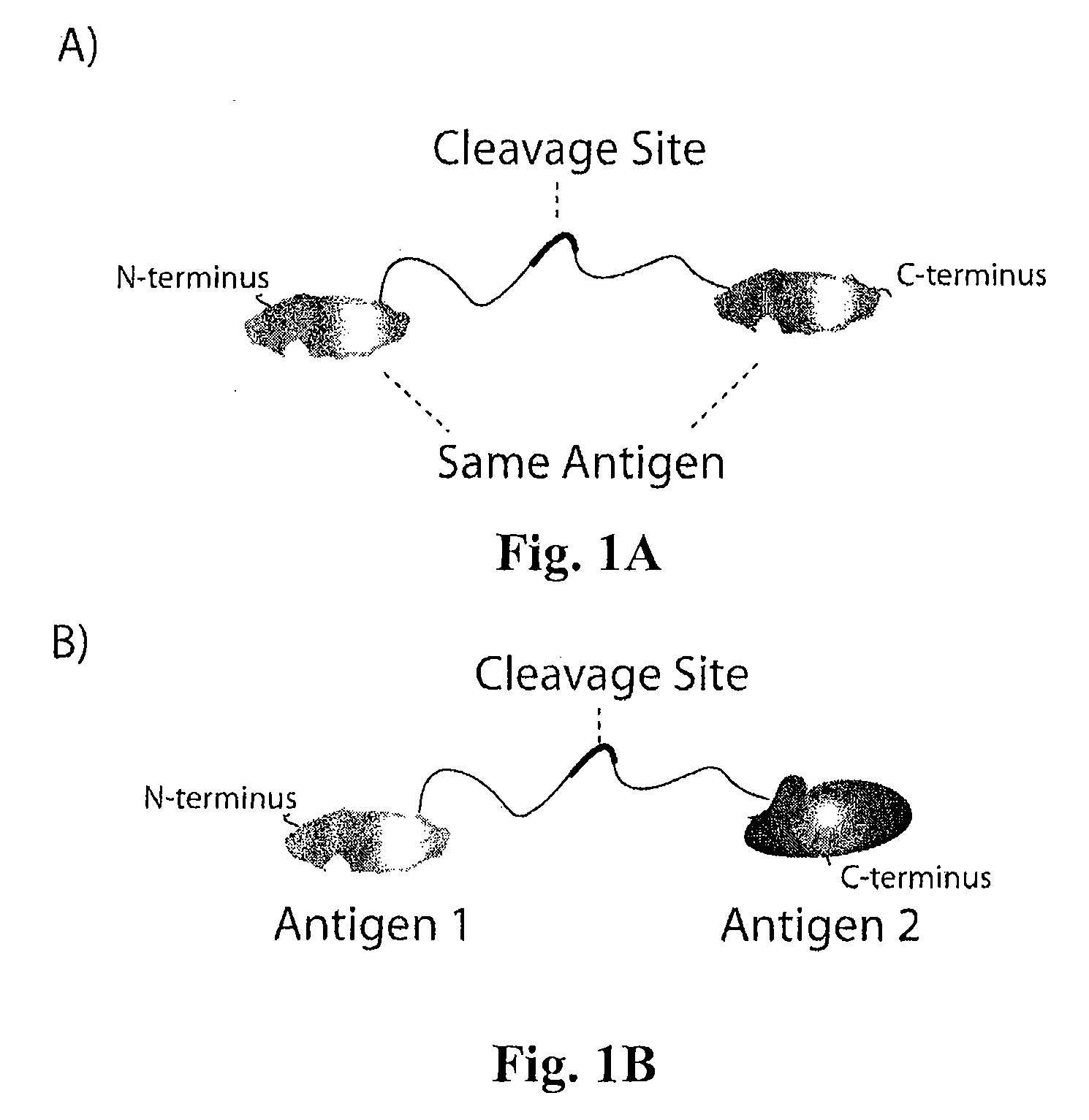Masking Ligands For Reversible Inhibition Of Multivalent Compounds
a multivalent compound and masking technology, applied in the field of masking ligands, can solve the problems of thwarting the intent, limiting the approach, and affecting the effect of the drug,
- Summary
- Abstract
- Description
- Claims
- Application Information
AI Technical Summary
Benefits of technology
Problems solved by technology
Method used
Image
Examples
example 1
A Multivalent Cleavable Masking Ligand Genetically Engineered to Conceal the Antigen Binding Site of Cetuximab (C225)and Matuzumab / 425
[0070]All constituent parts of the multivalent masking ligand hereafter referred to as TGP1 were expressed from one recombinant gene (FIG. 4A). A single protein comprising, in order, a Cetuximab / Matuzumab(425) binding mask (EGFR domain III epitope), a glycine-serine linker containing an MMP-9 cleavage site (GGGSGGGSGGGSVPLSLYSGSTSGSGKSSEGSGSGAQG) (SEQ ID NO:11) and a second Cetuximab / Matuzumab(425) binding mask were manufactured by automated chemical DNA synthesis. A polyhistidine purification tag (6-His) was included at the C-terminal end of the recombinant gene construct to aid in the purification of the recombinant protein. Although the two masks in this example are identical, they may also be distinct in order to link two distinct antibodies as described in the legend to FIG. 4. The recombinant gene was then ligated into the baculotransfer express...
example 2
Preparation of a Mask to Conceal the Antigen Binding Site of a mAb and is Chemical Connection of the Mask to a Linker to Form a Masking Ligand
[0079]This is a prophetic example. Arecombinant mask can be produced and purified using the recombinant protein expression technologies outlined above and then connected by chemical modification to a second mask via a linker. A reactive group can be added to the N-terminus of the first mask protein via N-terminal transamination, for example as described by Scheck and Francis, ACS Chemical Biology 2: 247-251, 2007; Scheck, et al., J. Am. Chem. Soc. 130: 11762-11770, 2008. The reactive group, a ketone or aldehyde, can then be used to chemically attach the linker protein to the mask proteins.
[0080]A linking peptide having the sequence of SEQ ID NO:5, wherein m=1 and n=1, can be chemically synthesized according to standard manufacturing protocols. The linking peptide can contain an alkoxyamine at one end and a reactive sulphur group at the other e...
example 3
Binding the Masking Ligand to the mAb or mAbs
[0083]This is a prophetic example. The multivalent masking ligand of Example 2 can be mixed at near stoichiometric amounts with a mAb for Cetuximab in a standard buffer, e.g., PBS, TBS, and allowed to bind to the antibody. The resulting stoichiometry of the masked antibody complex will be 1:1 or 2:2 masking ligand:antibody. Size exclusion chromatography can be used to purify the desired product. The molecular mass of the 1:1 admixture will be approximately 225 kDaltons (antibody is ˜150 kD and masking ligand is ˜75 kD). The molecular mass of the 2:2 admixture will be approximately 450 kD. In this example, the masks of the multivalent masking ligand are identical.
[0084]To produce a hetero-masking (non-identical) ligand, distinct antibodies, e.g., anti-Her2 and anti-IGFR, can be mixed with the hetero-masking ligand at a 1:1:2 ratio and allowed to bind with the antibodies. Size exclusion chromatography can be used to purify the masked antibo...
PUM
| Property | Measurement | Unit |
|---|---|---|
| Pharmaceutically acceptable | aaaaa | aaaaa |
| Affinity | aaaaa | aaaaa |
Abstract
Description
Claims
Application Information
 Login to View More
Login to View More - R&D
- Intellectual Property
- Life Sciences
- Materials
- Tech Scout
- Unparalleled Data Quality
- Higher Quality Content
- 60% Fewer Hallucinations
Browse by: Latest US Patents, China's latest patents, Technical Efficacy Thesaurus, Application Domain, Technology Topic, Popular Technical Reports.
© 2025 PatSnap. All rights reserved.Legal|Privacy policy|Modern Slavery Act Transparency Statement|Sitemap|About US| Contact US: help@patsnap.com



